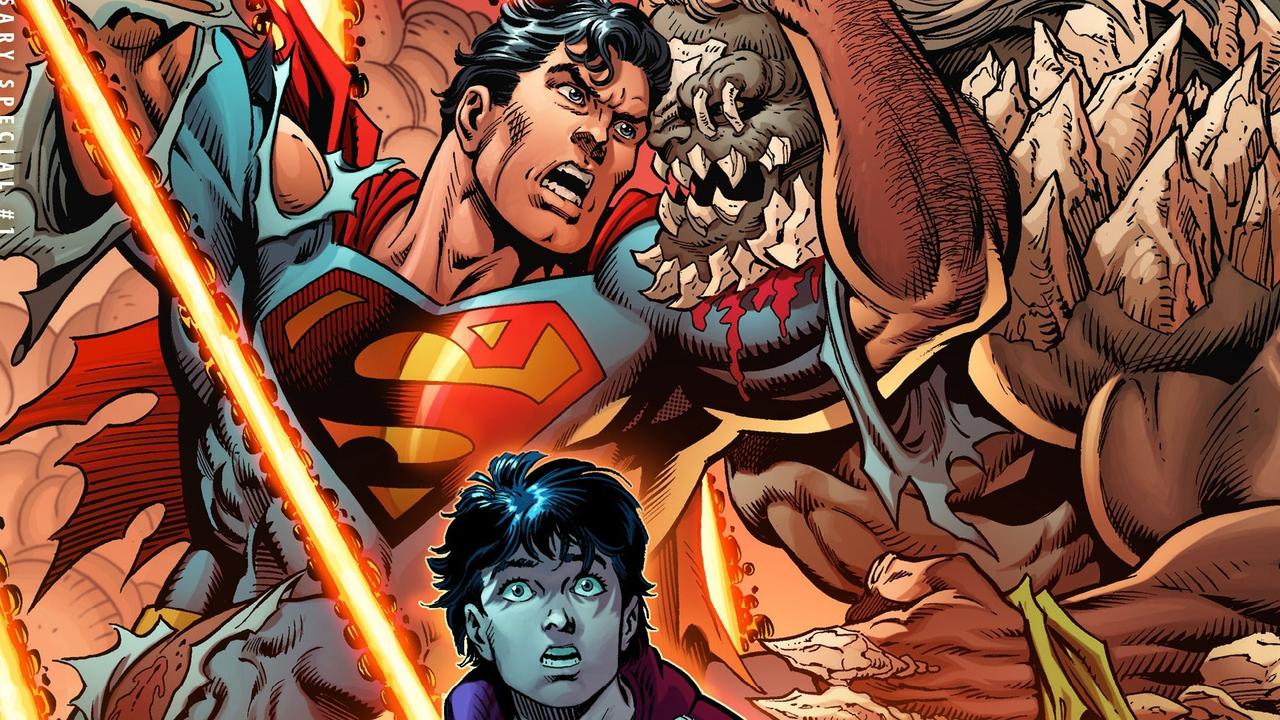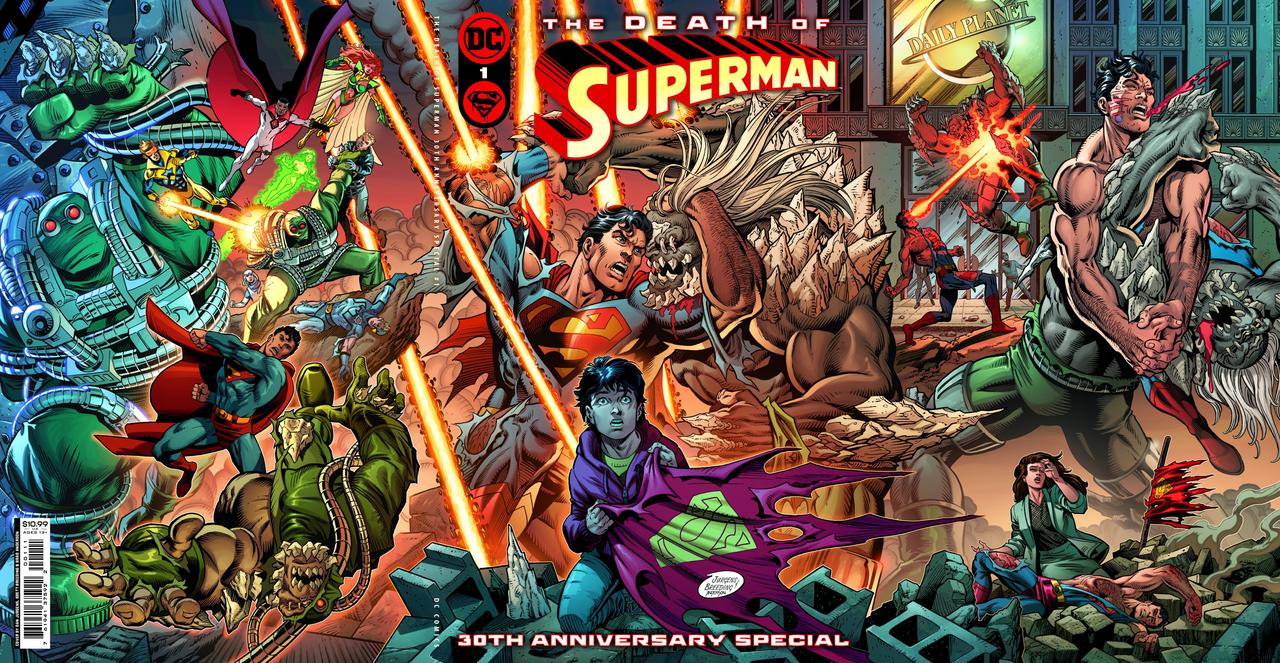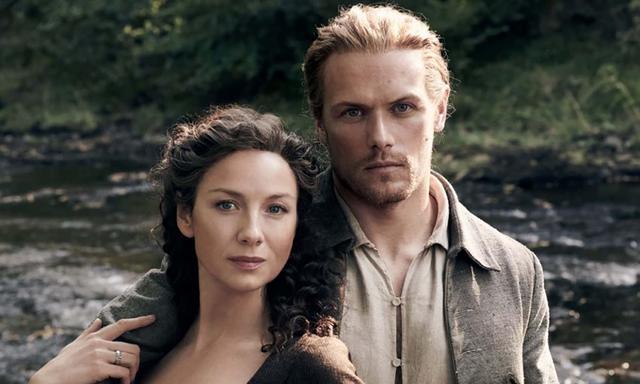If you click on a link and make a purchase we may receive a small commission. Read our editorial policy.
The Death of Superman: Dan Jurgens reflects on the event’s legacy with a new story
As DC celebrates the 30th anniversary of The Death of Superman with an oversized special reuniting its creative teams, Dan Jurgens reflects on the legacy of the iconic event.

The seminal 1992 DC Comics storyline 'The Death of Superman' catapulted the Man of Steel into the public eye, as Superman gave his life defeating the monstrous Doomsday in the streets of Metropolis. The iconic battle reached its lethal conclusion in Superman #75 (vol. 2), written and penciled by Dan Jurgens and inked by Brett Breeding, as the culmination of a crossover between the various Superman titles and Justice League. The storyline was an enormous success and a milestone moment for the character that has been heavily referenced and adapted into various multimedia over the subsequent 30 years.
The creative teams behind the original 'Death of Superman' – Dan Jurgens, Brett Breeding, Jerry Ordway, Tom Grummett, Doug Hazelwood, Louise Simonson, Jon Bogdanove, Roger Stern, and Butch Guice – are reuniting for this November’s The Death of Superman 30th Anniversary Special #1. The oversized anthology issue features a collection of all-new short stories examining the legacy of Superman’s demise, both in the immediate aftermath and years later within the DC Universe, while echoing Superman #75 by coming in a black polybag
Jurgens is teaming up with Brett Breeding, colorist Brad Anderson, and letterer John Workman for a story featuring Jon Kent learning about his father’s death from a young man named Mitch Anderson, who witnessed the battle as a boy. This revelation coincides with the arrival of a new supervillain Doombreaker, a monstrous beast who resembles and possesses the destructive raw power of Doomsday, with Superman leaping into action to face this threat.
In an exclusive interview with Popverse, Jurgens explains the themes of this new story, reflects on the legacy of 'Death of Superman,' and shares the fun in bringing the creative teams back together for this special.

In the original 'Death of Superman,' Clark was engaged, but he was still largely doing his own thing. In this special, Clark is a husband and father. While you’ve written him in that capacity before, how was it approaching that dynamic within this context?
Dan Jurgens: It certainly makes it a little bit different, and part of that I think is that Superman has changed over the last 30 years. I think he stands to be a little bit of a different character than he was back then. I know that even after John Byrne had done the reengineering of the character, we were all intentionally doing Superman as a younger characte, whereas now he’s a little bit more reserved because he is a bit older and he does have a family.
I think that comes through in this story and very much what it’s about along with the idea that Jon is there as the point-of-view for readers who weren’t necessarily there in 1992. I think it does reflect that change that can happen over three decades of time.
I feel like Jon is about the same age as Mitch Anderson was in 1992.
A bit younger, but yeah.
How was it bringing Mitch back in this story to tell what happened and have Jon realize this happened to his dad?
That was fun because, if we go back to that time, Mitch was very much representative of the 'Superman is boring, I’m not going to read Superman' crowd that was around at that time. I can’t remember if it was an issue of Justice League or Superman that I wrote and drew, with Mitch saying “I like Guy Gardner. He’s cool!” because Guy was the most acerbic character that DC had back then.
He stood for that, and to bring him back as an adult to explain all this to Jon after making that conversion himself, I thought was a fun and appropriate thing to do and also something that helped stay in touch with those stories from 30 years ago.

I feel that Jon also represents questions surrounding Superman's resurrection, like 'Is this one of your powers too?' How was it filtering that perspective through Jon?
Those are questions that I got at that time and have gotten since, with Jon saying “Can you do that again? Can I do that?” which I think is fun and probably the natural question that any nine or 10-year-old kid would have. It all goes along with this idea of what we were doing in this story, building in a little bit of this commentary of what the times were like.
In this story we say “The eyes of the world were on Metropolis,” and that’s clearly a reference for what was happening to all of us at that time. The eyes of much of the world was on the comic book industry because we were doing this thing called 'The Death of Superman.' It was on network news, every local news station, and things like that. Obviously, there’s this bit of meta commentary going on at the same time.
We’d be remiss if we didn’t mention the artwork. How was it working with Brett Breeding again in drawing and designing this more mature Superman and his family?
It was a lot of fun to get back together with Brett again. We had been doing work on covers but this is our first interior work in a solid 25-27 years. We had a lot of fun getting back together on this and going through the exercise of drawing these things again. We’d get on the phone and start to reminisce about the difficulties of this and that or just how long it takes to do Doomsday – or in this case Doombreaker – because the bones get quite noodly and do take quite a lot of time. [laughs]
That was a lot of fun, and it was fun seeing all the artwork from all the stories and scripts come across as we got everybody back together again.

In talking about Doombreaker, you sort of subvert what a Doomsday can be. What was it about designing this new twist on a familiar foe for this story?
It was a conscious idea to have a problem that is solvable here because I think what we have often in comics is a lot of characters who just are there to stop the bad guy, so to speak. For Superman, I think that it should go to the next level beyond that, that it’s not just stop the bad guy, but also solve the problem. Let’s find an answer to the condition that created this in the first place-- I think that’s when it becomes much more of a Superman story.
That was important to do here, and, behind Doomsday if you look at how he was created, which was this constant engineering of dying over and over again, it’s kind of a sympathetic origin. We don’t really get that with Doomsday now, but I did want to have a villain, if you will, who was somewhat sympathetic here. I think that gives a little bit of a different twist from what it was 30 years ago.
Outside of Mike Carlin, the band is back together for this. How was it getting all the creative teams back together for this special?
It was fun, and I think that was something that was set in stone from the start. It had to be the original creative teams, and we’re fortunate that everybody is still here and able to take part in that way. We did want to involve Mike as much as we possibly could in these things now. As we started to pull everybody together, first the invitations went out to the writers – Roger Stern, [Louise] Simonson, and Jerry Ordway. After we had them on board, it was the artists because, as I told them, if they couldn’t do it, it wouldn’t be the same. The idea really had to be to get everybody on board who was there at the time, and we tried to do that on every extent possible.
What were the logistical challenges in constantly handing off the narrative baton to each creative team to tell a larger story but still giving everyone their own space to play?
There are a couple of different considerations to that. The first one is just the idea that you have to start with a detailed plan, which we always had in terms of our charts and everything that we put together and somebody to administer that. That was Mike, in terms of how we could keep that train running. Beyond that, what you had to have was a mutual respect across the board for all the creatives involved and their willingness to put aside some of their own things that they thought was better or right for the good of the whole. I think we were all really good about that, that we all understood when it was time to put ego aside for the sake of the project.
I think in that particular storyline, through 'Funeral for a Friend' and 'Reign of the Supermen,' that we were able to do that to great success and build, really for that whole year, what turned out to be an extremely unique story in comics that, to this day, I don’t think probably gets the credit that it should for just being a really good story. When you put those three things together and read them as one solid storyline, that is exceptionally good comic book storytelling.

Within the space of this special, you’re able to tell a story with a clear beginning, middle, and end. How creatively fulfilling did you find that-- or do you prefer the longer-form comic book storytelling?
I think there’s a place obviously for both, and there are advantages and disadvantages to both. The advantage to the long-form storytelling that goes across all four books is that you can tell a story that you couldn’t otherwise tell. When I was writing Action Comics during the Rebirth days, because we had two issues per month – as most of the DC books did at that time – you could tell some stories in a way that would’ve been different if you had told them only monthly comics. You can go places you wouldn’t otherwise go because you have the luxury of being able to hit readers in a shorter amount of time to tell that story; you aren’t asking them to hang around quite as long, and that’s a luxury-- and fun way to tell a story.
At the same time, for something like this 30th anniversary special, it is nice to tell a story with a beginning, a middle, and an end. What I think would’ve been a mistake here would’ve been to come out with a six-issue set of minis where we were all spread out all over the place. I think what does make this fun is that it’s a one-shot that commemorates that event in and of itself, and we get different takes on that from the four creative teams involved.
In the 30 years since the original storyline’s publication, we’ve seen it adapted and referenced in Superman: The Animated Series, Batman v. Superman: Dawn of Justice, and the DC Universe Original Animated Movie. What is the secret core to this story that makes it work across all of its iterations?
I don’t think it’s a secret. I think what makes the story work is that it’s Superman. He is the most important constant across all of these things. If it’s a third or fourth-level character called Popsicle Man, people aren’t going to care as much, and you’re probably not going to have a sitting President eulogize Popsicle Man.
I think what is so important to this is that it’s Superman, who is the cornerstone character of this industry. The things you say about him, the level of caring we have about that, and the level of importance that Superman holds is just not extended elsewhere. If you start with that as the center of the story and everything else works around that, it should still work out no matter the medium. Whether it’s live-action TV, film, or animation, it should work no matter what.
Across the passage of time, seeing the story adapted, and hearing fan response, has there been anything that made you see the original story in a different light?
I don’t know about seeing it so much in a different light. I think what I have enjoyed is seeing the different attempts to recreate some of those moments. It’s been interesting to see Doomsday now where we’ve seen him in film, in two different TV series – Krypton and Smallville – and to see the different takes on that. It’s been interesting to see Doomsday in animation. I think what I’ve come to appreciate more is the breadth of the different attempts at this and how they all work.
In Batman v. Superman, there is a very specific scene that existed in the comics that they tried to then recreate in the film. Zack Snyder gives us a shot of Lois holding Superman’s body. It’s one thing to see your characters interpreted for film, it’s another thing to see a specific scene that you drew interpreted for film. It’s been fun across the board.
I know you created Booster Gold, but what made him the right character to name Doomsday?
We were working on this story, and, as we were planning it out, I was also writing and drawing Justice League. I just said there in the meeting as we were sitting there planning for the Superman books, I brought up the question if we wanted the Justice League to take part in this and if I could include those issues as well. The general thought was, yes, of course, because that’s what would turn it a bit more into a DC event. In working on the story itself where Doomsday doesn’t really speak – he kind of growls and grunts – where does the name come from?
Once we had that, I said that somebody has to name the character. At first, I was playing around with the idea of who it might be, and somehow it just felt like it was something that Booster might say. Even in this new story, in the 30th anniversary special, when we introduce Doombreaker, we needed someone to name the character. I figured Jon would be perfect because, in a way, Booster is sort of like a 10-year-old kid, so they’ve got something in common there. I thought it was a logical leap.

What are you most excited about getting to share this anniversary special, and how do you think it speaks to the legacy of the 'Death of Superman?'
I’m sitting here and have already seen the black bag edition, and I think, for all those people who remember buying that, they’re going to have a lot of fun seeing it again and going through that whole experience of whether they should [open] the bag, not open the bag, or buy two so that they have one to read and one not to. What I’m excited about is that, for people who were there when we did these stories. We were talking about some of the things we had forgotten, and it was fun to go down memory lane and re-experience them again and have things come back that we had all forgotten about entirely. To have that sense of what it was like, because those days were truly exciting at that time, to have that reawakened for them.
By the same token, I’m excited for readers who weren’t there to read this and get some sense of what it was like in those times. I’m sure there will be people who go in those stores, and they won’t necessarily know what this is, and the retailers will say they remember what it was like with a line out the door that was two blocks long.
To this day, I don’t do a con or store signing anywhere where someone doesn’t come up to me and say that the 'Death of Superman' got them into comics or their dad picked it up for them on the way home from work or their mom let them skip school that day so that they could go to the store. Everyone has those stories, and I think this will especially appeal to them.
With stories written by Dan Jurgens, Jerry Ordway, Louise Simonson, and Roger Stern, and illustrated by Jurgens, Brett Breeding, Tom Grummett, Doug Hazelwood, Jon Bogdanove, and Butch Guice, The Death of Superman 30th Anniversary Special #1 goes on sale Nov. 8 from DC Comics.
Superman, Lois, and Jon reunite with Dan Jurgens and Lee Weeks inside Action Comics in 2023
Follow Popverse for upcoming event coverage and news
Find out how we conduct our review by reading our review policy
Let Popverse be your tour guide through the wilderness of pop culture
Sign in and let us help you find your new favorite thing.
















Comments
Want to join the discussion? Please activate your account first.
Visit Reedpop ID if you need to resend the confirmation email.